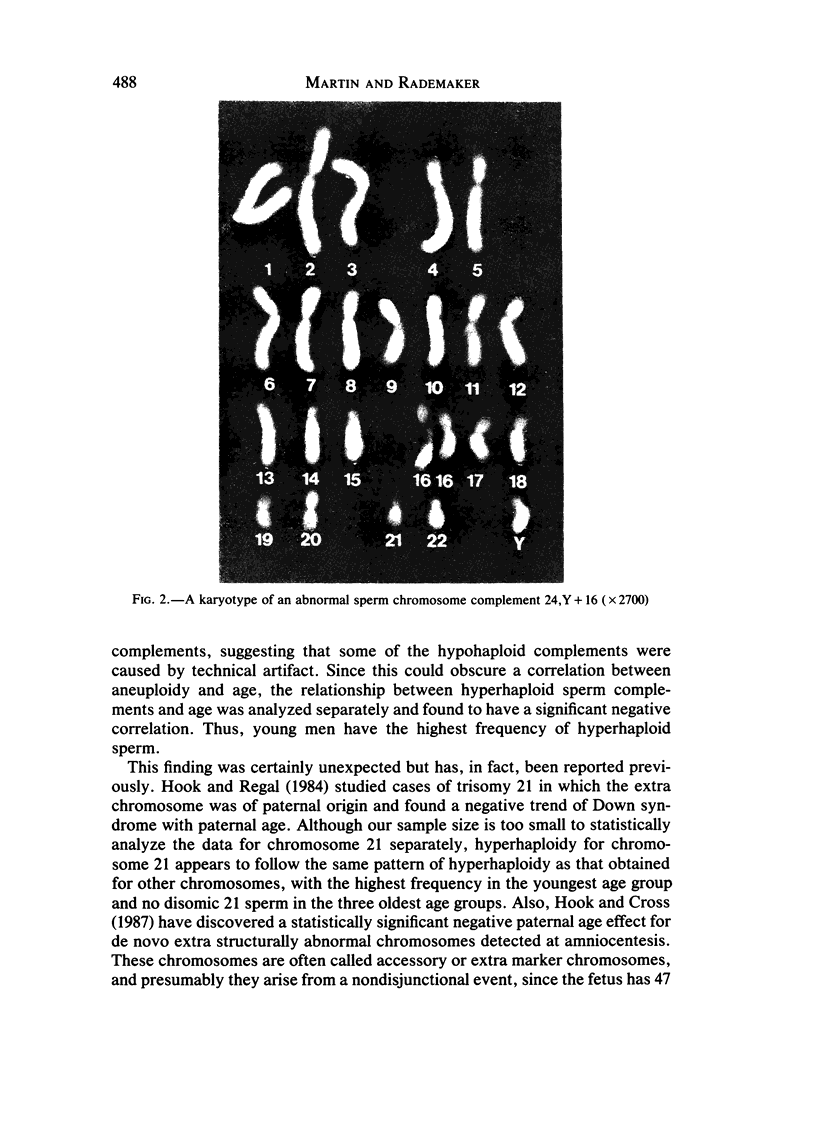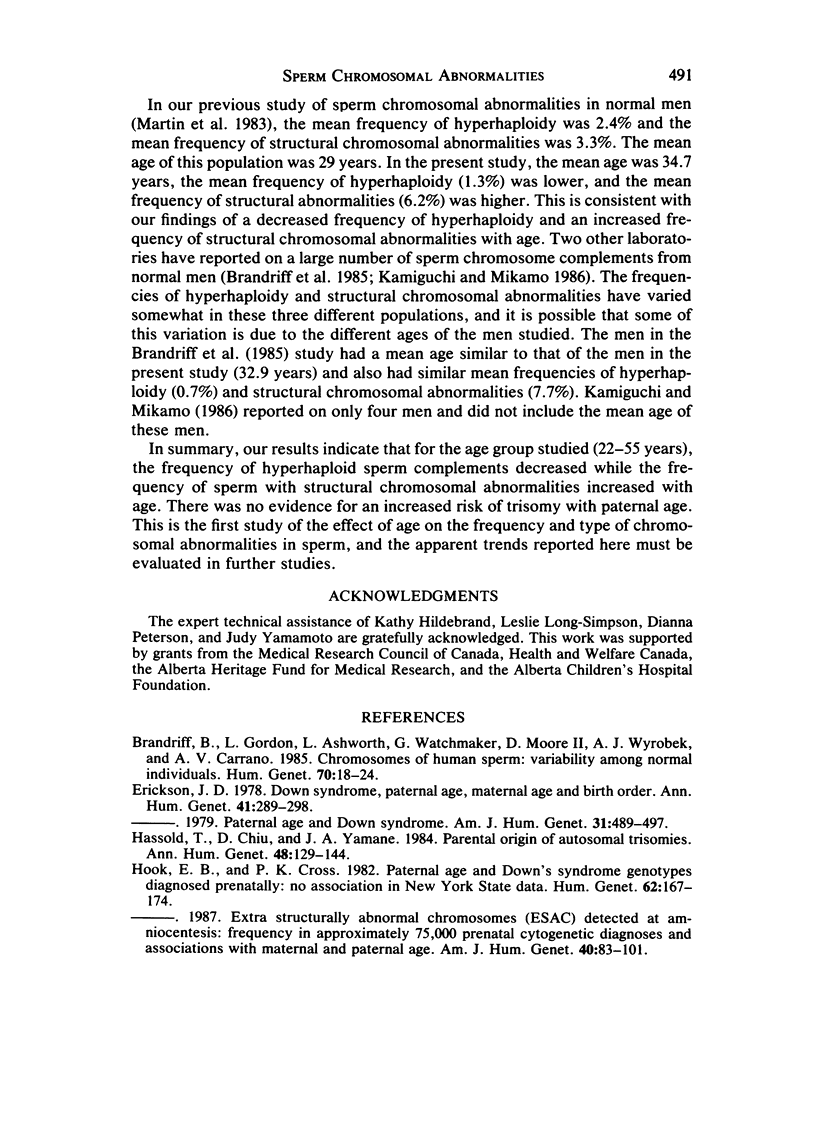Abstract
It has been suggested that advanced paternal age (independent of maternal age) is associated with an increased incidence of trisomy. However, studies of human liveborn offspring and of data from prenatal diagnosis have yielded conflicting results. To investigate this possible paternal age effect, we have studied sperm chromosome complements from 30 normal men of proven fertility stratified by age, with five males in each of six age categories (20-24, 25-29, 30-34, 35-39, 40-44, and 45+ years). Sperm chromosome complements were visualized after penetration of golden-hamster oocytes. A minimum of 30 complements were analyzed for each male. The analysis was performed blindly, without knowledge of the donor's age. The mean frequency of sperm chromosomal abnormalities in the individual men was 10.4% with means of 4.7% for numerical abnormalities and 6.2% for structural abnormalities. There was no relationship between age and the frequency of numerical abnormalities in sperm. Since there was a significant difference between the frequency of hyperhaploid and hypohaploid complements, these two types of numerical abnormalities were analyzed separately. There was no correlation between the frequency of hypohaploid complements and age. There was a significant negative correlation between age and the frequency of hyperhaploid complements. For structural abnormalities, there was a highly significant positive correlation with age. Thus, our results do not support the hypothesis of an increased risk of trisomy with paternal age.
Full text
PDF








Images in this article
Selected References
These references are in PubMed. This may not be the complete list of references from this article.
- Brandriff B., Gordon L., Ashworth L., Watchmaker G., Moore D., 2nd, Wyrobek A. J., Carrano A. V. Chromosomes of human sperm: variability among normal individuals. Hum Genet. 1985;70(1):18–24. doi: 10.1007/BF00389451. [DOI] [PubMed] [Google Scholar]
- Erickson J. D. Down syndrome, paternal age, maternal age and birth order. Ann Hum Genet. 1978 Jan;41(3):289–298. doi: 10.1111/j.1469-1809.1978.tb01896.x. [DOI] [PubMed] [Google Scholar]
- Hassold T., Chiu D., Yamane J. A. Parental origin of autosomal trisomies. Ann Hum Genet. 1984 May;48(Pt 2):129–144. doi: 10.1111/j.1469-1809.1984.tb01008.x. [DOI] [PubMed] [Google Scholar]
- Hook E. B., Cross P. K. Paternal age and Down's syndrome genotypes diagnosed prenatally: no association in New York state data. Hum Genet. 1982;62(2):167–174. doi: 10.1007/BF00282309. [DOI] [PubMed] [Google Scholar]
- Hook E. B., Regal R. R. A search for a paternal-age effect upon cases of 47, +21 in which the extra chromosome is of paternal origin. Am J Hum Genet. 1984 Mar;36(2):413–421. [PMC free article] [PubMed] [Google Scholar]
- Kamiguchi Y., Mikamo K. An improved, efficient method for analyzing human sperm chromosomes using zona-free hamster ova. Am J Hum Genet. 1986 May;38(5):724–740. [PMC free article] [PubMed] [Google Scholar]
- Marlhens F., Achkar W. A., Aurias A., Couturier J., Dutrillaux A. M., Gerbault-Sereau M., Hoffschir F., Lamoliatte E., Lefrançois D., Lombard M. The rate of chromosome breakage is age dependent in lymphocytes of adult controls. Hum Genet. 1986 Aug;73(4):290–297. doi: 10.1007/BF00279088. [DOI] [PubMed] [Google Scholar]
- Martin R. H. A detailed method for obtaining preparations of human sperm chromosomes. Cytogenet Cell Genet. 1983;35(4):252–256. doi: 10.1159/000131876. [DOI] [PubMed] [Google Scholar]
- Martin R. H., Balkan W., Burns K., Rademaker A. W., Lin C. C., Rudd N. L. The chromosome constitution of 1000 human spermatozoa. Hum Genet. 1983;63(4):305–309. doi: 10.1007/BF00274750. [DOI] [PubMed] [Google Scholar]
- Matsunaga E., Tonomura A., Oishi H., Kikuchi Y. Reexamination of paternal age effect in Down's syndrome. Hum Genet. 1978 Feb 16;40(3):259–268. doi: 10.1007/BF00272186. [DOI] [PubMed] [Google Scholar]
- Mikkelsen M., Poulsen H., Grinsted J., Lange A. Non-disjunction in trisomy 21: study of chromosomal heteromorphisms in 110 families. Ann Hum Genet. 1980 Jul;44(Pt 1):17–28. doi: 10.1111/j.1469-1809.1980.tb00942.x. [DOI] [PubMed] [Google Scholar]
- Pendić B., Barjaktarović N., Kostić V. Chromosomal aberrations in persons accidentally irradiated in Vinca 19 years ago. Radiat Res. 1980 Mar;81(3):478–482. [PubMed] [Google Scholar]
- Regal R. R., Cross P. K., Lamson S. H., Hook E. B. A search for evidence for a paternal age effect independent of a maternal age effect in birth certificate reports of Down's syndrome in New York state. Am J Epidemiol. 1980 Nov;112(5):650–655. doi: 10.1093/oxfordjournals.aje.a113037. [DOI] [PubMed] [Google Scholar]
- Roberts D. F., Callow M. H. Origin of the additional chromosome in Down's syndrome: a study of 20 families. J Med Genet. 1980 Oct;17(5):363–367. doi: 10.1136/jmg.17.5.363. [DOI] [PMC free article] [PubMed] [Google Scholar]
- Roecker G. O., Huether C. A. An analysis for paternal-age effect in Ohio's Down syndrome births, 1970-1980. Am J Hum Genet. 1983 Nov;35(6):1297–1306. [PMC free article] [PubMed] [Google Scholar]
- Roth M. P., Feingold J., Baumgarten A., Bigel P., Stoll C. Reexamination of paternal age effect in Down's syndrome. Hum Genet. 1983;63(2):149–152. doi: 10.1007/BF00291534. [DOI] [PubMed] [Google Scholar]
- Roth M. P., Stoll C., Taillemite J. L., Girard S., Boué A. Paternal age and Down's syndrome diagnosed prenatally: no association in French data. Prenat Diagn. 1983 Oct;3(4):327–335. doi: 10.1002/pd.1970030409. [DOI] [PubMed] [Google Scholar]
- Steenland K., Carrano A., Ratcliffe J., Clapp D., Ashworth L., Meinhardt T. A cytogenetic study of papaya workers exposed to ethylene dibromide. Mutat Res. 1986 Jun;170(3):151–160. doi: 10.1016/0165-1218(86)90029-7. [DOI] [PubMed] [Google Scholar]
- Stene J., Stene E., Stengel-Rutkowski S., Murken J. D. Paternal age and Down's syndrome: data from prenatal diagnoses (DFG). Hum Genet. 1981;59(2):119–124. doi: 10.1007/BF00293059. [DOI] [PubMed] [Google Scholar]
- Working P. K., Butterworth B. E. An assay to detect chemically induced DNA repair in rat spermatocytes. Environ Mutagen. 1984;6(3):273–286. doi: 10.1002/em.2860060304. [DOI] [PubMed] [Google Scholar]




